|
|
|
Sort Order |
|
|
|
Items / Page
|
|
|
|
|
|
|
| Srl | Item |
| 1 |
ID:
128388
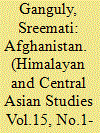

|
|
|
|
|
| Publication |
2011.
|
| Summary/Abstract |
In the context of conventional notion of Afghanistan's foreign policy strategy, two countries are accorded the most prominent status- the U.S. and Pakistan. Russia, on the other hand, shares a unique relationship with Afghanistan. The role of the buffer state, as played out by Afghanistan, during the 19"' century, halted Russian adventure towards ' South Asia, and Russian invasion of Afghanistan proved to be so much of a miscalculated affair as the misadventure led to the collapse of the Soviet Union itself. But even now, Russia has a great stake in Afghanistan's stability and is still considered to be a stabilizing factor in Afghanistan's security scenario. This paper analyzes the different phases of Russian involvement in Afghanistan in t international strategic environment.
|
|
|
|
|
|
|
|
|
|
|
|
|
|
|
|
| 2 |
ID:
104260
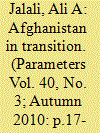

|
|
|
| 3 |
ID:
130607
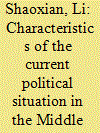

|
|
|
|
|
| Publication |
2014.
|
| Summary/Abstract |
By comparison with the "Arab Spring" that swept through the whole Bregion in 2011 and the political transition evident in many Arab countries in 2012, political development in the Middle East in 2013, to many observers, seemed lost in chaos. Arab countries undergoing political change were plagued by disorder, volatility, and violence. With US. strategic withdrawal from the region imminent, geopolitical dynamics
regrouped. Struggles among regional powers entered a new stage. Four characteristics of the Middle East situation are harbingers for future outcomes: political "ehaos" in the Arab world, "flux and reflux" between moderate and radical lslamists, geopolitical shocks caused by the strategic withdrawal of the U.S. from the region, and continued uncertainty over the Iranian nuclear issue.
|
|
|
|
|
|
|
|
|
|
|
|
|
|
|
|
| 4 |
ID:
129909
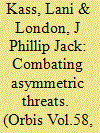

|
|
|
|
|
| Publication |
2014.
|
| Summary/Abstract |
The overarching objective of this analysis is to examine the ways and means by which the United States could take the asymmetric battle-space and win against the ever-changing array of threats posed by nation-states and non-state actors. Today's security challenges are predominantly hybrids: offense and defense; symmetric and asymmetric; synchronous and asynchronous; regular and irregular; geographically-focused and globally-ubiquitous. This reality requires multi-dimensional thinking, nuanced approaches, and nimble, decisive execution guided by a new strategic paradigm. Fighting on the enemy's terms, scoring short-term wins at unjustifiably high costs in lives, treasure and lost opportunities is simply unacceptable.
|
|
|
|
|
|
|
|
|
|
|
|
|
|
|
|
| 5 |
ID:
184594
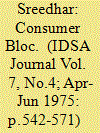

|
|
|
| 6 |
ID:
112114
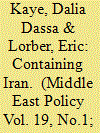

|
|
|
| 7 |
ID:
142173
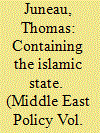

|
|
|
|
|
| Summary/Abstract |
In early 2014, the organization then known as the Islamic State in Iraq and the Levant swept across northwestern Iraq while simultaneously expanding the territory under its control in eastern Syria. The group, which renamed itself the Islamic State (IS) in June 2014, is led by members of what used to be al-Qaeda in Iraq. It has incorporated Iraqi Sunnis who hold grievances against the Shia-dominated government in Baghdad (mostly former members of Saddam Hussein's regime and alienated tribes) as well as a variety of armed Syrian opposition groups. By mid-2014, IS threatened to further expand in Iraq and Syria, while there were plausible fears that it could cross into neighboring countries, especially Jordan. It has entrenched sectarian divisions and further weakened the state in Iraq and has worsened an already devastating civil war in Syria. It represents a magnet and a safe haven for terrorists in the heart of the Middle East.
|
|
|
|
|
|
|
|
|
|
|
|
|
|
|
|
| 8 |
ID:
170919
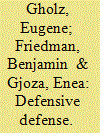

|
|
|
| 9 |
ID:
034951
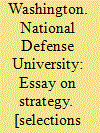

|
|
|
|
|
| Publication |
Washington, D C, National Defence University Press, 1985.
|
| Description |
103p.
|
|
|
|
|
|
|
|
|
|
|
|
Copies: C:1/I:0,R:0,Q:0
Circulation
| Accession# | Call# | Current Location | Status | Policy | Location |
| 026061 | 355.40973/NAT 026061 | Main | On Shelf | General | |
|
|
|
|
| 10 |
ID:
116641
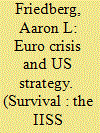

|
|
|
|
|
| Publication |
2012.
|
| Summary/Abstract |
For 45 years after the end of the Second World War, American strategists worried far more about Europe's perceived political, economic and military weakness than they did about its potential strength. Following the fall of the Berlin Wall and the end of the Cold War this pattern was briefly reversed. With the signing of the Treaty of Maastricht in 1992 the birth of a 'United States of Europe' seemed finally to be at hand. Possessed of a vast market and nascent institutions of central governance, this new entity was widely seen as having the potential to become a major player on the world stage.
|
|
|
|
|
|
|
|
|
|
|
|
|
|
|
|
| 11 |
ID:
105035
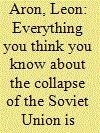

|
|
|
|
|
| Publication |
2011.
|
| Summary/Abstract |
Every revolution is a surprise. Still, the latest Russian Revolution must be counted among the greatest of surprises. In the years leading up to 1991, virtually no Western expert, scholar, official, or politician foresaw the impending collapse of the Soviet Union, and with it one-party dictatorship, the state-owned economy, and the Kremlin's control over its domestic and Eastern European empires. Neither, with one exception, did Soviet dissidents nor, judging by their memoirs, future revolutionaries themselves. When Mikhail Gorbachev became general secretary of the Communist Party in March 1985, none of his contemporaries anticipated a revolutionary crisis. Although there were disagreements over the size and depth of the Soviet system's problems, no one thought them to be life-threatening, at least not anytime soon.
|
|
|
|
|
|
|
|
|
|
|
|
|
|
|
|
| 12 |
ID:
180383
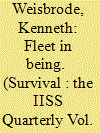

|
|
|
|
|
| Summary/Abstract |
Contemporary American statecraft should be based empirically on the existence of a polycentric world and the role of multilateral institutions within it.
|
|
|
|
|
|
|
|
|
|
|
|
|
|
|
|
| 13 |
ID:
157311
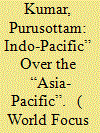

|
|
|
|
|
| Summary/Abstract |
During US president Donald Trump’s recent trip to Asia, he repeatedly used the term ‘Indo-Pacific’, instead of using ‘Asia-Pacific’, to denote the Asian region. It gave a sudden boost to the use of the term in the annals of the White House and, unsurprisingly, irked China.
|
|
|
|
|
|
|
|
|
|
|
|
|
|
|
|
| 14 |
ID:
086376
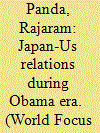

|
|
|
|
|
| Publication |
2009.
|
| Summary/Abstract |
It is premature to predict how Japan-US relations will be shaped under Obama. The real test, as said before, will be Obama's Iraq policy and Japan's role in the US strategy. When the senior Bush was in the White House, the end of the cold war in the early 1990's gave him a "peace dividend" - a drop in military spending that opened the door to fund more constructive federal programs. Obama would probably hope for the same advantage should he manage to wind up the war in Iraq as promised during the election.The savings are potentially substantial.
|
|
|
|
|
|
|
|
|
|
|
|
|
|
|
|
| 15 |
ID:
128058
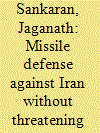

|
|
|
|
|
| Publication |
2013.
|
| Summary/Abstract |
All recent U.S. efforts after the conclusion of the 2010 New Strategic Arms Reduction Treaty (New START) to move ahead on bilateral nuclear arms reductions with Russia have stalled over Russian concerns regarding the capabilities of the European Phased Adaptive Approach, as the Obama administration's missile defense policy in Europe is formally known, and its effect on Russian nuclear retaliatory potential.Since the early stages of the phased adaptive approach, Russian officials have cited it as an obstacle to further nuclear arms reduction. Last March, however, U.S. Secretary of Defense Chuck Hagel announced a restructuring of the approach, canceling the planned implementation of its fourth phase, which had prompted the strongest Russian complaints.[1] The key feature of that phase was the deployment of the Standard Missile-3 (SM-3) IIB interceptors in Poland. The SM-3 IIB, with a planned velocity of 5.5 kilometers per second, would have had the ability to fly further and faster than any other missile in the system
|
|
|
|
|
|
|
|
|
|
|
|
|
|
|
|
| 16 |
ID:
102696
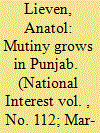

|
|
|
|
|
| Publication |
2011.
|
| Summary/Abstract |
U.S. STRATEGY toward Pakistan is focused on trying to get Islamabad to give serious help to Washington's campaign against the Afghan Taliban. There are two rather large problems with this approach. The first is that it is never going to happen. As U.S. diplomats in Pakistan themselves recognize (and as was made ever so clear by the WikiLeaks dispatches), both Pakistani strategic calculations and the feelings of the country's population make it impossible for Islamabad to take such a step, except in return for U.S. help against India-which Washington also cannot deliver.
|
|
|
|
|
|
|
|
|
|
|
|
|
|
|
|
| 17 |
ID:
139493
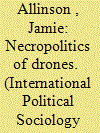

|
|
|
|
|
| Summary/Abstract |
The rapid increase in the use and capabilities of Unmanned Aerial Vehicles (UAVs), or “drones,” has led to debates on their place in US strategy, particularly their use in assassination missions, or so-called targeted killings. However, this debate has tended to focus narrowly on two questions: first, whether the US use of UAVs to assassinate its enemies, including US citizens, is legal, and second, whether drones should be given the autonomy to decide when to kill humans. This paper uses the concept of “necro-politics”—the arrogation of the sovereign's right both to command death and to assign grievable meaning to the dead—as it emerges in the work of Achille Mbembe to criticize the assumptions of these questions. It is argued that debates over endowing drones with the autonomy to kill humans assume that the current human operators of drones work outside of the context of racial distinction and colonial encounter in which they already make decisions to kill. The paper supports this argument with reference to the text of a US investigation into a strike which killed civilians in Uruzgan province, Afghanistan.
|
|
|
|
|
|
|
|
|
|
|
|
|
|
|
|
| 18 |
ID:
179385
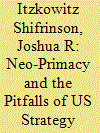

|
|
|
|
|
| Summary/Abstract |
Over the last half decade, a bipartisan consensus has emerged in US foreign policy circles calling for sustained competition with China. The ostensible goals of this competition are to protect the extant international order, block Chinese regional hegemony, and defend American allies—all of which notionally require major changes in US grand strategy.
|
|
|
|
|
|
|
|
|
|
|
|
|
|
|
|
| 19 |
ID:
152146
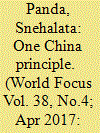

|
|
|
|
|
| Summary/Abstract |
US president Donald J Trump indicated reversal of several US policies with unwonted alacrity to reinforce “America First” and “Make America Great Again” .One of these is writing a new script for its “One China” Strategy. Probably interdependence and perceived outcomes of breaking the norm in the US-ROC-PRC triangular relationship compelled him to repair the damage but US “One China Policy” is not clearly defined.
|
|
|
|
|
|
|
|
|
|
|
|
|
|
|
|
| 20 |
ID:
185482
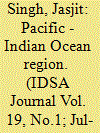

|
|
|
|
|
|
|
|